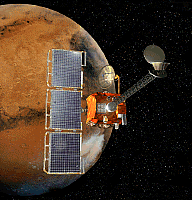 Description
Description
 Description
Description
The 2001 Mars Odyssey is the remaining part of the Mars Surveyor 2001 Project, which originally consisted of two separately launched missions, The Mars Surveyor 2001 Orbiter and the Mars Surveyor 2001 Lander. The lander spacecraft was cancelled as part of the reorganization of the Mars Exploration Program at NASA. The orbiter, renamed the 2001 Mars Odyssey, will nominally orbit Mars for three years, with the objective of conducting a detailed mineralogical analysis of the planet's surface from orbit and measuring the radiation environment. The orbiter will also act as a communications relay for future missions to Mars over a period of five years.
Mission Profile
The launch window for the 2001 Mars Odyssey opens on 30 March 2001. After launch
on a Delta II and a seven month cruise the spacecraft will reach Mars on 20
October 2001. The spacecraft will use a propulsive maneuver to transfer into a
25-hour capture orbit and use aerobraking over the next two months, until 30
December 2001, to achieve a 2-hour, approximately 400 x 400 km polar science
orbit. The Orbiter will act as a communications relay for the Mars 2003 Rovers,
scheduled to arrive in January 2004, and possibly other future missions. Data
will be collected from orbit until the end of the nominal mission on 12 November
2003. The spacecraft will continue to act as a relay until 4 October 2005. Spacecraft
and Subsystems The 2001 Mars Odyssey will carry star cameras, the Martian
Radiation Environment Experiment (MARIE), which will measure the near-space
radiation environment as related to the radiation-related risk to human
explorers, the Thermal Emission Imaging System (THEMIS), which will map the
mineralogy of the martian surface using a high-resolution camera and a thermal
infrared imaging spectrometer, and the Gamma-Ray Spectrometer (GRS), which will
map the elemental composition of the surface and determine the abundance of
hydrogen in the shallow subsurface. The main body of the orbiter is box-shaped,
with the science deck holding the science instruments on top. A long boom
extends out normal to the science deck with the GRS mounted on the end. A set of
solar arrays is extends out from one side of the main bus. A parabolic high-gain
dish antenna is mounted on a mast extending from one corner of the bus. The main
engine is in the lower part of the bus, with the nozzle directed out the bottom.
Propellant tanks are mounted around the main engine.